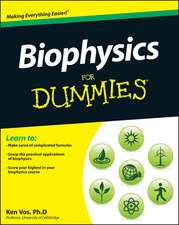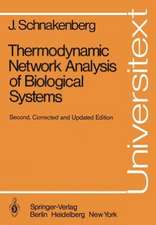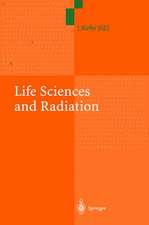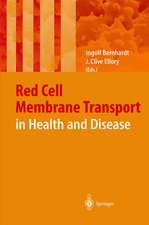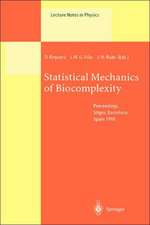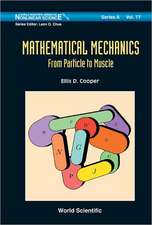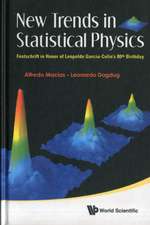Physical Principles of Biomembranes and Cells: Biological and Medical Physics, Biomedical Engineering
Autor Kazuo Ohki, Hidetake Miyataen Limba Engleză Hardback – 23 oct 2018
The author introduces the relationship between functions and physical properties in biomembranes, explaining the methods and equipment used in biophysics research to help researchers unravel the still-unsolved mysteries of life. The physical principles needed to understand the cellular functions are provided; these functions are associated with biomembranes and regulated by physical properties of the lipid bilayer such as membrane fluidity, phase transition, and phase separation, as shown in lipid rafts. Other key dynamic aspects of life (cell locomotion, cytoskeletal dynamics, and sensitivities of the cell to physical stimuli such as external forces and temperature) are also discussed. Lastly, readers will learn how life on Earth and its ecological system are maintained by solar energy, and be provided further information on the problems accompanying global warming.
| Toate formatele și edițiile | Preț | Express |
|---|---|---|
| Paperback (1) | 635.01 lei 43-57 zile | |
| Springer – 10 ian 2019 | 635.01 lei 43-57 zile | |
| Hardback (1) | 641.20 lei 43-57 zile | |
| Springer – 23 oct 2018 | 641.20 lei 43-57 zile |
Din seria Biological and Medical Physics, Biomedical Engineering
- 5%
 Preț: 1110.32 lei
Preț: 1110.32 lei - 18%
 Preț: 1006.55 lei
Preț: 1006.55 lei - 18%
 Preț: 960.78 lei
Preț: 960.78 lei - 18%
 Preț: 704.11 lei
Preț: 704.11 lei - 18%
 Preț: 967.40 lei
Preț: 967.40 lei - 18%
 Preț: 948.92 lei
Preț: 948.92 lei - 15%
 Preț: 641.71 lei
Preț: 641.71 lei - 15%
 Preț: 644.95 lei
Preț: 644.95 lei - 15%
 Preț: 665.08 lei
Preț: 665.08 lei - 18%
 Preț: 1669.16 lei
Preț: 1669.16 lei - 18%
 Preț: 941.05 lei
Preț: 941.05 lei - 18%
 Preț: 956.81 lei
Preț: 956.81 lei - 18%
 Preț: 950.21 lei
Preț: 950.21 lei - 15%
 Preț: 636.80 lei
Preț: 636.80 lei - 18%
 Preț: 947.50 lei
Preț: 947.50 lei - 15%
 Preț: 636.80 lei
Preț: 636.80 lei -
 Preț: 397.01 lei
Preț: 397.01 lei - 18%
 Preț: 1236.99 lei
Preț: 1236.99 lei - 15%
 Preț: 644.49 lei
Preț: 644.49 lei - 18%
 Preț: 946.55 lei
Preț: 946.55 lei - 15%
 Preț: 712.22 lei
Preț: 712.22 lei - 18%
 Preț: 952.89 lei
Preț: 952.89 lei - 18%
 Preț: 944.36 lei
Preț: 944.36 lei - 18%
 Preț: 1228.29 lei
Preț: 1228.29 lei - 5%
 Preț: 1422.67 lei
Preț: 1422.67 lei - 18%
 Preț: 1393.27 lei
Preț: 1393.27 lei - 15%
 Preț: 651.19 lei
Preț: 651.19 lei - 18%
 Preț: 953.65 lei
Preț: 953.65 lei - 18%
 Preț: 955.88 lei
Preț: 955.88 lei - 15%
 Preț: 644.95 lei
Preț: 644.95 lei - 5%
 Preț: 1098.48 lei
Preț: 1098.48 lei - 18%
 Preț: 959.19 lei
Preț: 959.19 lei - 15%
 Preț: 643.65 lei
Preț: 643.65 lei - 5%
 Preț: 1159.16 lei
Preț: 1159.16 lei - 5%
 Preț: 1102.67 lei
Preț: 1102.67 lei - 18%
 Preț: 952.09 lei
Preț: 952.09 lei - 18%
 Preț: 946.55 lei
Preț: 946.55 lei - 18%
 Preț: 952.09 lei
Preț: 952.09 lei - 15%
 Preț: 703.20 lei
Preț: 703.20 lei - 18%
 Preț: 953.65 lei
Preț: 953.65 lei - 5%
 Preț: 1008.45 lei
Preț: 1008.45 lei - 15%
 Preț: 644.82 lei
Preț: 644.82 lei - 18%
 Preț: 956.03 lei
Preț: 956.03 lei - 15%
 Preț: 647.40 lei
Preț: 647.40 lei
Preț: 641.20 lei
Preț vechi: 754.36 lei
-15% Nou
Puncte Express: 962
Preț estimativ în valută:
122.73€ • 133.36$ • 103.16£
122.73€ • 133.36$ • 103.16£
Carte tipărită la comandă
Livrare economică 21 aprilie-05 mai
Preluare comenzi: 021 569.72.76
Specificații
ISBN-13: 9784431568391
ISBN-10: 4431568395
Pagini: 170
Ilustrații: XIII, 170 p. 94 illus., 25 illus. in color.
Dimensiuni: 155 x 235 x 13 mm
Greutate: 0.44 kg
Ediția:1st ed. 2018
Editura: Springer
Colecția Springer
Seria Biological and Medical Physics, Biomedical Engineering
Locul publicării:Tokyo, Japan
ISBN-10: 4431568395
Pagini: 170
Ilustrații: XIII, 170 p. 94 illus., 25 illus. in color.
Dimensiuni: 155 x 235 x 13 mm
Greutate: 0.44 kg
Ediția:1st ed. 2018
Editura: Springer
Colecția Springer
Seria Biological and Medical Physics, Biomedical Engineering
Locul publicării:Tokyo, Japan
Cuprins
Physics in the Origin of Life.- Cells and Biomembranes.- Methods for physical properties of biomembranes and cells.- Structure and Physical Properties of Biomembranes.- Structure and function of protein.- Physical properties of biomembranes and cellular functions.- Moving life.- Global environment and Biophysics.
Notă biografică
Prof.Kazuo Ohki
Emeritus Professor of Tohoku University
ohki@bio.phys.tohoku.ac.jp
Prof.Hidetake Miyata
Department of Physics, Tohoku University
miyata@bio.phys.tohoku.ac.jp
Emeritus Professor of Tohoku University
ohki@bio.phys.tohoku.ac.jp
Prof.Hidetake Miyata
Department of Physics, Tohoku University
miyata@bio.phys.tohoku.ac.jp
Textul de pe ultima copertă
This book describes how biologically available free energy sources (ATP, chemical potential, and membrane potentials, among others) can be used to drive synthetic reactions, signaling in cells, and various types of motion such as membrane traffic, active transport, and cell locomotion. As such, it approaches the concept of the energy cycle of life on Earth from a physical point of view, covering topics ranging from an introduction to chemical evolution, to an examination of the catalytic activity of enzymes associated with the genome in Darwinian evolution.
The author introduces the relationship between functions and physical properties in biomembranes, explaining the methods and equipment used in biophysics research to help researchers unravel the still-unsolved mysteries of life. The physical principles needed to understand the cellular functions are provided; these functions are associated with biomembranes and regulated by physical properties of the lipid bilayer such as membrane fluidity, phase transition, and phase separation, as shown in lipid rafts. Other key dynamic aspects of life (cell locomotion, cytoskeletal dynamics, and sensitivities of the cell to physical stimuli such as external forces and temperature) are also discussed. Lastly, readers will learn how life on Earth and its ecological system are maintained by solar energy, and be provided further information on the problems accompanying global warming.
The author introduces the relationship between functions and physical properties in biomembranes, explaining the methods and equipment used in biophysics research to help researchers unravel the still-unsolved mysteries of life. The physical principles needed to understand the cellular functions are provided; these functions are associated with biomembranes and regulated by physical properties of the lipid bilayer such as membrane fluidity, phase transition, and phase separation, as shown in lipid rafts. Other key dynamic aspects of life (cell locomotion, cytoskeletal dynamics, and sensitivities of the cell to physical stimuli such as external forces and temperature) are also discussed. Lastly, readers will learn how life on Earth and its ecological system are maintained by solar energy, and be provided further information on the problems accompanying global warming.
Caracteristici
Answers the question of what life on the earth is in terms of energy by providing examples such as the origin and evolution of cells and the regulation of cellular functions Shows that regulation of the activities of enzymes and functional proteins such as receptors, channels, etc is achieved by conformational changes in those proteins Describes the essentials of free energy transduction and the regulation of cellular functions in biological systems and several models of force production for growing polymers Demonstrates the importance of efficiently using solar energy to solve worldwide problems such as the food crisis and global warming




